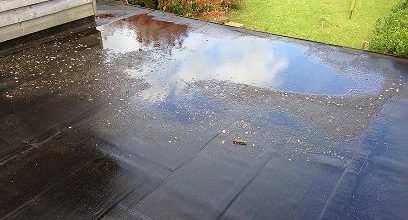‘Ponding’ is one of the biggest clues that a flat roof is approaching its expiry date and will provide inadequate protection in the future. The term ‘ponding’ refers to a situation in which water collects in ponds on a flat roof some 48 hours after a downpour.
‘Ponding’ of any kind suggests poor water drainage and will inevitably reduce the life-expectancy of the roof, causing structural damage, leakage and potential vegetation growth over time.
Homeowners don’t necessarily have to witness the ponds of water on their flat roof to find out whether they have a problem. Dirty circles on the flat roof or signs of algae or vegetation growth are big clues.
There are many reasons why ‘ponding’ occurs on flat roofs. Poor design can play a significant factor in ‘ponding’ with no slope for drainage. Another cause is structural sagging which creates an uneven surface, allowing water to collect in pools, and disrupting correct drainage.
However, the greatest risk of damage comes from the weight of the water which can result in the roof collapsing unexpectedly. Ponding water is estimated to weigh 5lbs per square foot of roof surface.
If several areas of the flat roof are affected by ‘ponding’, this is a significant load to withstand. There are various maintenance treatments which can protect your flat roof against ‘ponding’.
Depending on the severity of the problem, it is also possible to repair a flat roof where water is regularly collecting in pools 48 hours after rain. However, if your flat roof was constructed from traditional materials such as felt or is approaching its life cycle, then it is advisable to replace with a superior product.
The single-ply RubberBond EPDM FleeceBack roofing system Projects4Roofing install, have acquired a worldwide reputation for quality and protection. The membranes are engineered to create a dimensionally stable waterproofing covering which is unaffected by expansion and contraction, which can cause an uneven surface to occur.
The synthetic material protects the roof from the damaging effects of the sun while the unique surface lacquer delivers 100% resistance to airborne chemicals including moss and algae growth.
RubberBond EPDM FleeceBack is highly resistant to dampness and ponding water which is why they are the first choice for growing numbers of homeowners and commercial building owners.
Regardless of whether or not you have noticed ‘ponding’ or other signs of deterioration, schedule in a maintenance check for a professional opinion. Many problems can be rectified if caught early on and where replacement is needed, this is better carried out before your household contents are damaged by a large leak.




